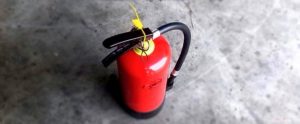
A fire extinguisher can save lives
Today we’re going to be offering a guide on how to clean up fire extinguisher residue. If you’ve ever experienced a fire at the workplace, you can attest to the relief of having a fire extinguisher handy. However, even if the fire is no longer burning, you shouldn’t walk away from your life-saving device. Also, you should follow different cleaning methods based on the type of fire extinguishers you own. Here is more information.
How to Clean Up Dry Chemical Fire Extinguisher Residue
Dry chemical fire extinguishers consist of firefighting agents such as monoammonium phosphate, sodium bicarbonate, and potassium bicarbonate, which leave behind a corrosive powder. Clean up the residue right away, especially if it touches metal surfaces. Here are a few helpful cleaning tips:
- Vacuum/sweep leftover debris
- Spray stuck-on residue with isopropyl alcohol and 50% warm water to dilute it; let it work its magic for a few minutes and wipe it off
- Neutralize sodium bicarbonate and potassium bicarbonate residue by applying mostly water and a little bit of vinegar for a few minutes and wiping with a wet rag
- Neutralize monoammonium phosphate residue by mixing baking soda and hot water into a paste, leave it for a few moments, and wipe the surface
- Give the entire impacted area a final wipe down with soap and water and use fans to dry the area
- Wash affected dishware or clothes in the sink, dishwasher, or washing machine as usual
How to Clean Up Class K Wet Chemical Fire Extinguisher Residue
Dry chemical fire extinguishers do not belong in commercial kitchens because of their corrosive nature. The most optimal fire extinguishers for commercial kitchens are Class K wet fire extinguishers. When oil and grease catch fire, Class K extinguishers release a mist that is ideal for cooling cooking surfaces and extinguishing flames. They consist of potassium acetate and have a low PH. Before you begin cooking again, here is what you should do:
- Shut off the power to all cooking equipment and put on gloves
- Wipe the foamy residue away with a sponge or cloth dipped in a hot soapy solution.
- Rinse off any surfaces that chemicals touched.
- Allow the entire area to dry before you power cooking equipment back on
Are you fire extinguishers up-to-date? Call us to ensure that they are. Fire safety is only as valid as the functionality of your fire protection equipment and systems.
Commercial and Residential Fire Prevention from Judd Fire Protection
If you want to ensure your home and business are safe throughout the year, trust Judd Fire Protection, LLC. We have over two decades of experience in designing, installing, inspecting, and repairing residential and commercial fire protection systems. We serve clients throughout Maryland, Pennsylvania, Washington, D.C., Virginia, and West Virginia. If you are interested in finding out more about our services and protecting your home and business, give us a call at 410-871-3480 or contact us online. For more fire safety tips, follow us on Facebook, Twitter, and Pinterest.
